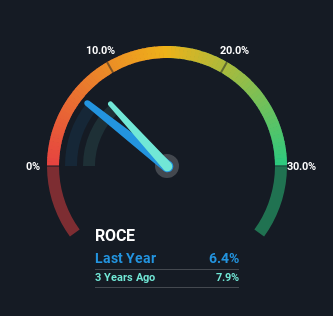- United States
- /
- Professional Services
- /
- NYSE:TRU
Returns At TransUnion (NYSE:TRU) Appear To Be Weighed Down
To find a multi-bagger stock, what are the underlying trends we should look for in a business? In a perfect world, we'd like to see a company investing more capital into its business and ideally the returns earned from that capital are also increasing. Basically this means that a company has profitable initiatives that it can continue to reinvest in, which is a trait of a compounding machine. However, after briefly looking over the numbers, we don't think TransUnion (NYSE:TRU) has the makings of a multi-bagger going forward, but let's have a look at why that may be.
What Is Return On Capital Employed (ROCE)?
If you haven't worked with ROCE before, it measures the 'return' (pre-tax profit) a company generates from capital employed in its business. Analysts use this formula to calculate it for TransUnion:
Return on Capital Employed = Earnings Before Interest and Tax (EBIT) ÷ (Total Assets - Current Liabilities)
0.064 = US$648m ÷ (US$11b - US$861m) (Based on the trailing twelve months to March 2024).
Thus, TransUnion has an ROCE of 6.4%. Ultimately, that's a low return and it under-performs the Professional Services industry average of 14%.
View our latest analysis for TransUnion

Above you can see how the current ROCE for TransUnion compares to its prior returns on capital, but there's only so much you can tell from the past. If you'd like to see what analysts are forecasting going forward, you should check out our free analyst report for TransUnion .
What Does the ROCE Trend For TransUnion Tell Us?
In terms of TransUnion's historical ROCE trend, it doesn't exactly demand attention. The company has consistently earned 6.4% for the last five years, and the capital employed within the business has risen 53% in that time. Given the company has increased the amount of capital employed, it appears the investments that have been made simply don't provide a high return on capital.
Our Take On TransUnion's ROCE
Long story short, while TransUnion has been reinvesting its capital, the returns that it's generating haven't increased. Unsurprisingly, the stock has only gained 5.7% over the last five years, which potentially indicates that investors are accounting for this going forward. Therefore, if you're looking for a multi-bagger, we'd propose looking at other options.
On a final note, we've found 1 warning sign for TransUnion that we think you should be aware of.
For those who like to invest in solid companies, check out this free list of companies with solid balance sheets and high returns on equity.
Valuation is complex, but we're here to simplify it.
Discover if TransUnion might be undervalued or overvalued with our detailed analysis, featuring fair value estimates, potential risks, dividends, insider trades, and its financial condition.
Access Free AnalysisHave feedback on this article? Concerned about the content? Get in touch with us directly. Alternatively, email editorial-team (at) simplywallst.com.
This article by Simply Wall St is general in nature. We provide commentary based on historical data and analyst forecasts only using an unbiased methodology and our articles are not intended to be financial advice. It does not constitute a recommendation to buy or sell any stock, and does not take account of your objectives, or your financial situation. We aim to bring you long-term focused analysis driven by fundamental data. Note that our analysis may not factor in the latest price-sensitive company announcements or qualitative material. Simply Wall St has no position in any stocks mentioned.
About NYSE:TRU
TransUnion
Operates as a global consumer credit reporting agency that provides risk and information solutions.
Proven track record and fair value.
Similar Companies
Market Insights
Community Narratives




